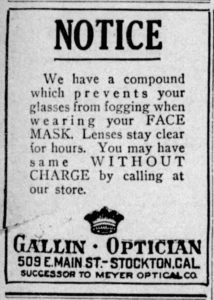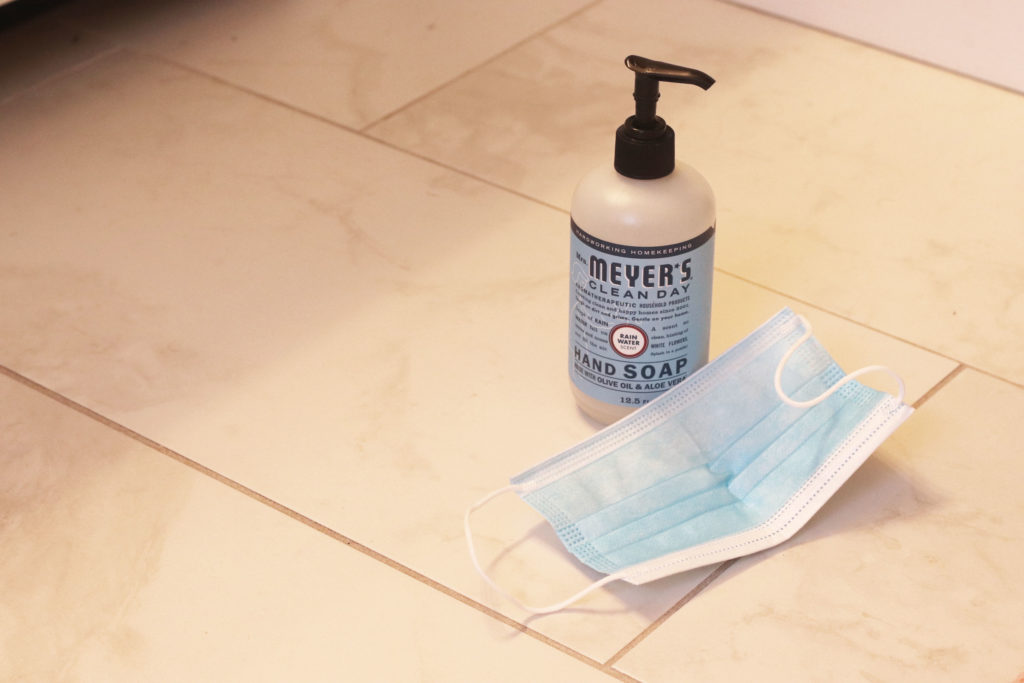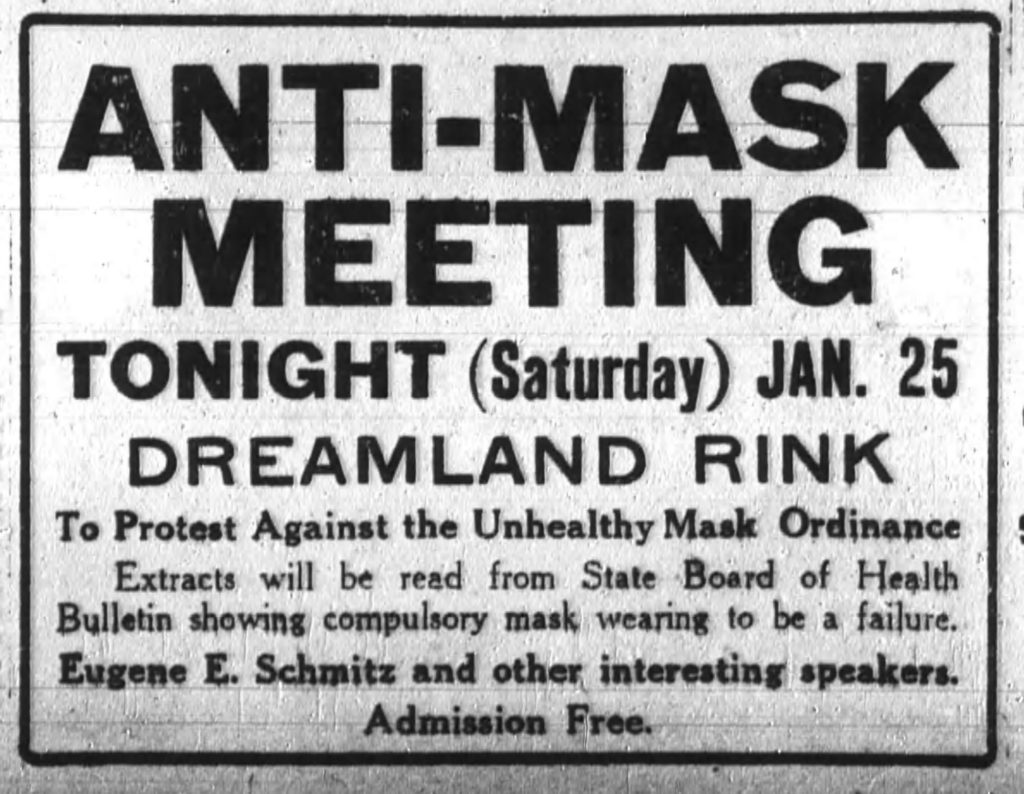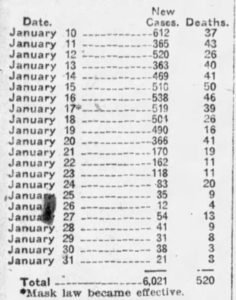Have a drink with: The 1919 Anti-Mask League
NO BARS, okay? NO.
Ask them about: Coughing in large groups
Since COVID-19 became a public health emergency in March, different cities and states have responded with protective measures, many of them including a recommendation or a requirement to wear a mask when in proximity to other people. These mandates have drawn protest from opponents, many of whom feel that masks are unnecessary, ineffective or a violation of individual rights. We can take a lesson from the influenza epidemic of 1918-1919, during which relaxed mask requirements may well have contributed to a resurgence of the virus in the San Francisco area after an initially successful lockdown period.
During the 1918-1919 flu, many Americans were big fans of masks – Red Cross workers made sure they were making and distributing tons, the Levi Strauss company went from making jeans to mask production, and as Atlas Obscura has pointed out, some people even masked their pets. But the flu roared back after an initial lull in illness, and a portion of Bay Area residents were not at all eager to mask back up. In language that could well have come from modern news reports, anti-maskers complained about masks being useless, about “political doctors,” and about “an infringement of our personal liberty.” In January 1919, a crowd of more than four thousand people gathered at a local rink to protest the passage of the city’s mask ordinance.
San Francisco acted in mid-October to close schools, churches and businesses in response to the influenza epidemic, and officially put a mask requirement into place on October 22. By city ordinance, anyone not wearing a mask in public would be subject to a fine or up to ten days’ jail time. The ordinance considered four-ply gauze ideal for masks, and required masks to cover a person’s nose and mouth. Medical historian Brian Dolan notes that at first police hit offenders with five-dollar tickets, but “gradually increased the fine as days went by,” and on one “particularly disobedient Saturday, 700 people were arrested for not wearing masks.” (That this then crowded the city jail added a wrinkle.)
Masks, though, worked. By November, flu case numbers were so low that city officials began to think the outbreak was done with, and they allowed public gatherings to resume. When the mask ordinance was lifted on November 21, citizens celebrated with large gatherings and a grand ceremonial stomping of the masks, and the city Board of Supervisors happily proclaimed fresh air and sunshine as the city’s best medicine. There was still a lot to be uncertain about, though: flu was most certainly not gone, case figures crept back upward, and businesses wondered about the impact of resumed mask-wearing on the Christmas shopping season.
The public and professional dialogue on mask-wearing was sort of a mess: even the Journal of the American Medical Association said that “the face mask has value in the prophylaxis of influenza,” but also acknowledged that the hard part was getting enough people to wear them correctly to have an impact. Some people felt masks were totally unnecessary; others simply found them annoying. It was hard to say who was doing what right: some cities restricted gatherings, some required masks, some didn’t; and authorities and citizens alike found space to disagree on what was most effective. Moreover, did anyone know enough about the virus to say anything conclusively? Was it possible that an entirely different cure was effective? (1919 had its dubious cures, too: “Mr. Bannerhof, 906 O’Farrell street, said that he had a positive preventive and cure in ‘Camerine,’ a nerve food.”)
With this stew of science, individualism, cabin fever and stress over World War I (oh yeah, don’t forget that was going on), San Francisco mayor “Sunny Jim” Rolph was not eager to dip his toe back into the roiling mask waters (someone had gone so far as to send a bomb to the city’s public health chief, after all). Nonetheless, rising illness and death figures forced the issue, and a new mask ordinance was passed at the Board of Supervisors’ January 17th meeting. Response from the anti-mask contingent was swift: at the January 27th meeting, protestors stated:
“We, the Committee delegated by the Anti-Mask League, which in mass meeting assembled to the number of 4,500, in Dreamland Rink, Saturday evening, January 25th, in fulfillment of our agreement then made, appear here today to respectfully request that you repeal the so-called Ordinance No. 4758 (New Series), familiarly known as the ‘Mask Ordinance.’ We earnestly pray that the people be granted speedy relief from the burdensome provisions of this measure.”
Supervisor Nelson wanted this protest referred to the Mayor for action, as mask-wearing “was an infringement of our personal liberty and that it was not in keeping with the spirit of a truly democratic people to compel people to wear the mask who do not believe in its efficacy, but rather that it is a menace to their health.”
Mayor Rolph, in response, put his Judge Dredd helmet on and replied that: “The mask ordinance is the law.” He pointed out that daily reports were showing a decline in cases thanks to masking:
“We are all for democracy,” Rolph continued, “and we all want to get rid of the masks when it is considered safe to do so. I don’t criticize the law. When laws are made, I respect and obey them. It is my duty to see that they are obeyed. As Mayor I represent all the people and must serve all the people, not any special class of the people. As Mayor I did not appoint this Board of Health originally. It was appointed by my predecessors, and I have retained them. They are honorable men; they are capable men, and they serve without pay. The Charter of San Francisco prescribes their duties. Do you think I am going to stultify myself here against the wish of 99 1/2 per cent of the doctors; against the officials of the army and navy? The people felt a great relief when the masking ordinance was put in effect. You don’t realize the misery and death that has followed this epidemic, nor the forces required to help these people. We should give our minds to serious matters instead of fighting the little inconvenience occasioned by the wearing of a mask for the protection of the general public.”
Turning his attention to the OTHER crisis occupying the nation, he chided: “We should do something for our returning soldiers who find themselves without jobs…I never hear of soldiers complaining against wearing the mask. Why don’t you do something for the returning soldiers instead of fighting against the methods employed by the Board of Health to stamp out the influenza epidemic?”
The mask ordinance was ultimately repealed on February 3rd, the epidemic considered at its end. (A smaller third wave appeared in the fall, but this was largely true.)
Fun Facts:
Yes, seriously, bomb threats against the city public health chief. The San Francisco Chronicle’s front page on December 18, 1918, shouted: “BOMB FOR DR. HASSLER,” and described a homemade terror. Three pounds of black powder, buck shot and broken glass were placed inside a can, wired with alarm clock parts and a match as a detonator. The package was addressed to Dr. Hassler, signed “Compliments from John,” and pasted with twelve three-cent postage stamps.
One advertiser at the time knew how to focus on the real issues with masks:

Dolan points out that the anti-mask movement, which was surprisingly well-organized and rigorously structured, was largely led by women with a larger agenda than influenza. The league was led by the lawyer, suffragette, and civil rights activist E.C. Harrington, who was active in local politics and may have wanted to use the effort to push for the Mayor’s resignation. Her vice-president was a schoolteacher and activist named Eily Grosjean, who led the Parents’ Rights League of America – a group that opposed things like in-school medical testing and pandemic-related school closures as an intrusion on parents’ rights to control their children’s health.
Additional Reading:
Journal of Proceedings, Board of Supervisors, City and County of San Francisco (1919)
Brian Dolan, “Unmasking History: Who Was Behind the Anti-Mask League Protests During the 1918 Influenza Epidemic in San Francisco?,” Perspectives in Medical Humanities (UC Medical Humanities Consortium, May 19, 2020)
“The Influenza Masks of 1918,” The Atlantic, July 16, 2020
National Archives, “Wear a Mask and Save Your Life: the 1918 Flu Pandemic”


